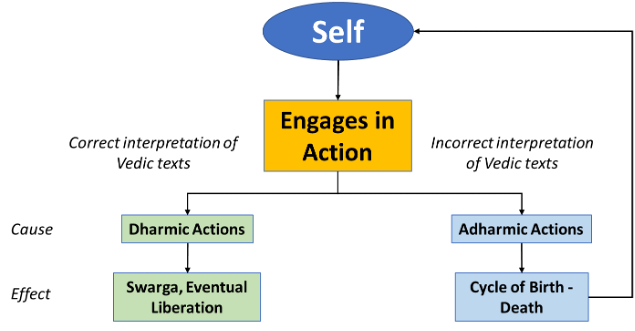Skip to main content
Doctrine of Purva Mimamsa Philosophy
Purva Mimamsa Darshana

1. Introduction
- Purva Mimamsa (Dharma Mimamsa) is paired with Vedanta (Uttara Mimamsa).
- Purva Mimamsa's tenets are based on the karma kanda of the Vedas (Brahmanas & Samhitas).
- Vedanta's tenets are based on the jnana kanda (Upanishads).
- Purva Mimamsa emphasizes Brahmanas (ritual aspect).
- Vedanta emphasizes Upanishads.
2. Goals & Differences
- Purva Mimamsa: Liberation (moksha) is achieved by engaging in Vedic rituals.
- Vedanta: Liberation (moksha) is achieved by total detachment from worldly activities.
- Purva Mimamsa does not accept the concept of Ishvara (God).
- It's a Vedic system that is not dependent on belief in Ishvara.
- Vedanta, to a large extent, accepts Ishvara.
3. Common Beliefs
- Both accept the existence of atman (self).
- Both believe in karma and rebirth of the atman in various physical forms due to karma.
- Both believe in a cycle of birth and death, and the goal is liberation.
4. Purva Mimamsa: Etymology and Core Tenets
-
Mimamsa: Reflection or critical investigation.
- Focus: Critically investigating the meaning of Vedic utterances.
- Vedic Utterances: Unauthored and eternal.
- Opposes Nyaya & Vaisheshika (Vedic utterances authored by Ishvara).
- Ishvara or god is not relevant to the understanding of Vedic utterances.
5. Goal of Purva Mimamsa
- To interpret and understand these unauthored Vedic utterances.
- Rules of interpretation are systematized by Jaimini Rishi (Mimamsa Sutras).
- Jaimini's Sutras are collection of 2500 sutras.
-
Sutra literature is followed by bhashya (commentary).
- Shabara Bhashya is a detailed commentary on Mimamsa Sutras.
- Commentaries further developed by Kumarila Bhatta and Prabhakara (leading to different schools).
- Bhatta School of Mimamsa
- Prabhakara School of Mimamsa
6. Purpose of Vedic Rituals
- This philosophy Provides a philosophical justification for continuing Vedic rituals.
- Liberation is achieved by performing Vedic rituals and accumulating punya (merit).
- Self is trapped in a cycle of birth and death.
- To break this cycle, one must engage in karma (action) that is permitted by the Vedas (dharmic action).
- Proper interpretation of Vedic text leads to dharmic actions.
- Result: Accumulation of punya, leading to swarga and ultimately, liberation.
- Improper interpretation leads to adharma & cycle of birth and death.
7. Importance of Interpretation (Mimamsa Rules)
- Purva Mimamsa provides a theory of interpretation & philosophy of language.
- Concerned with the interpretation of Vedic utterances for dharmic goal realisation.
- Principles can be developed into a general theory of interpretation or hermeneutics.
- Can be applied in other areas (like legal treatises).
- Mimamsa rules help navigate complex articles/laws.
- Mimamsa rules are interpretative rules, contextual rules etcetera.
- Rules are used to see how things are connected to each other.
- Mimamsa rules can be applied in general discourses and discourse analysis.


No Comments